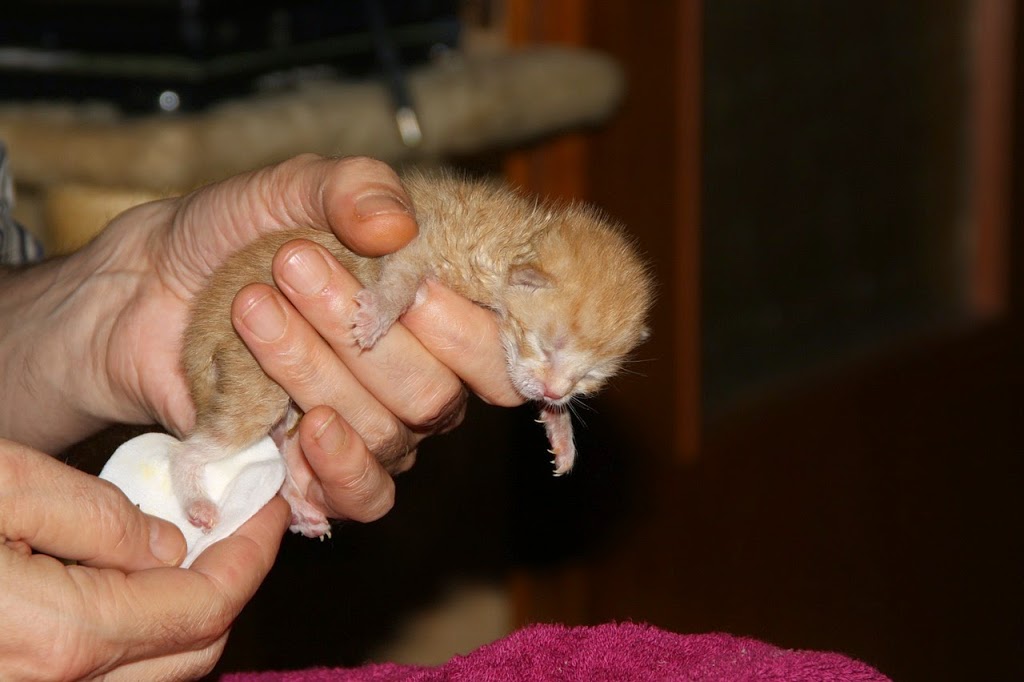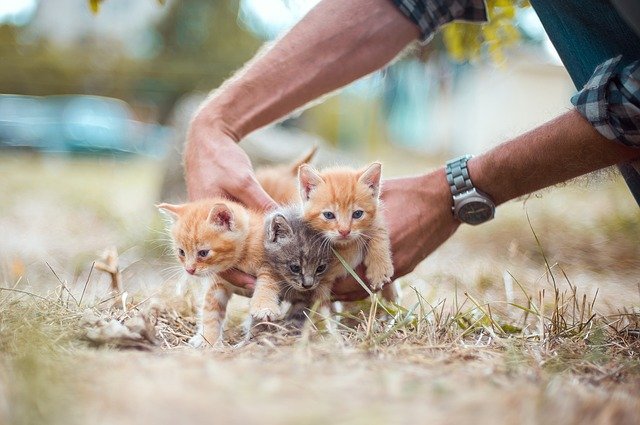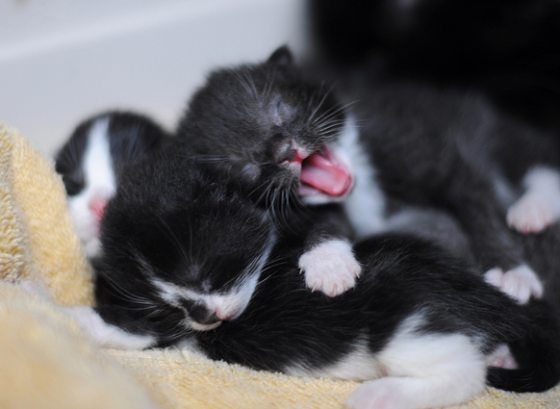It’s hard to imagine that the call of nature doesn’t come naturally for some species.
In humans, when the urge to go comes, you simply go. Even a newborn baby can interpret the signals of going to the bathroom and will do the needful. You don’t need to push the little one to poo or pee.
Sadly, the story is not the same for our little feline friends.
Anyone that has adopted a kitty less than one month old knows they don’t eliminate on their own.
If mommy is around, she is responsible for getting her babies to go. She does that by licking her kittens’ anuses to stimulate elimination.
If a mother cat is nowhere to be seen, you should take up the mantle.
Since you cannot mimic mommy’s action (yuck!), what can you do instead?
We have the entire scoop for you in this guide.
Why Can’t Kittens Eliminate On Their Own?
According to Dr. Marty Becker, the fact that cats under three weeks old cannot poop on their own is a survival tactic.
In the wild, the mommy cat stimulates elimination by herself to control the time and place of elimination.
At such an age, the little ones are very vulnerable. Managing their eliminations protects them from danger.
Over the years, cats have adapted to this evolutionary approach. Even if there’s no danger around, a baby kitten will need help to stimulate her to go the bathroom.
What to Do?

To get your kitten to eliminate, you have to arouse the same (or close) feeling her mother gives when running her tongue over her nether regions.
Here’s how to do it.
What You Need
- Soft cloth, baby wipes, a warm cotton ball, or soft tissue. Choose light-colored clothes to help identify the color of the pee or poo
- Warm water
Before Dinner
Before mealtime, you want to stimulate your kitty to pee and if possible, poop.
To do it, soak a soft cloth in warm water. A warm baby wipe or a cotton ball does the job perfectly as well.
Next, hold the kitten with her tummy in your palms and massage her privates in circular motions with the warm cloth.
Be as gentle as possible. The pressure should be equal to massaging your baby’s eyelids.
The gentle circular motions mimic the mother cat’s tongue and will stimulate the kitty to empty her bladder and possibly, her bowels.
The little bathroom break before dinner helps make more room for dinner.
The kitty should pee in less than a minute.
Ensure that the pee is cotton yellow. If it is darker, it means the poor kitty is dehydrated and thus needs more water in her system.
Keep massaging until she poops. Don’t stop until she’d done eliminating.
The poop should be mustard yellow or brown.
The right consistency should be that of toothpaste. If it is runny or bears colors such as green, white, yellow, and pasty gray, it means she has diarrhea or infection.
Call the vet immediately.
After Dinner
Once your baby is full, grab and pet her for a while.
Be gentle especially around her belly area as it will be swollen with the meal taken by then. You want her to calm down and relax.
After 15 minutes, stimulate her to eliminate by following the same procedure above.
Keep petting as you massage her belly and nether regions for about one minute or until he pees or poops.
After elimination, clean the anus by wiping it with a soft dry cloth.
How long does it take to stimulate a kitten to poop?
According to many kitty experts, it takes 10-40 seconds to get results when stimulating a kitten to poop.
Sometimes it takes several trials to get the kitty to pass stool.
Be patient throughout the process. Keep massaging after the kitten releases the poop. Only stop after she’s done doing the deed.
What Happens If The Cat Doesn’t Eliminate?
Arnold Plotnick, DVM, calls kittens “little eating and pooping machines.” According to him, the little guys eliminate several times a day.
Hannah Shaw of Kittenlady.org echoes the same by stating that kittens defecate 1-6 times a day.
If your kitty goes for 24 hours without passing stool, don’t worry. If she’s eating normally and doesn’t have any symptoms of being sick, don’t panic.
In light of this, don’t expect results every time you stimulate your kitty to use the bathroom. Perhaps the kitty is not ready to pass stool yet.
If you massage for a minute and nothing comes out, put down your tools and try again later.
Having said that, you should watch out for any tell-tale signs that your kitty isn’t okay.
If she has gone for more than two days without pooping, she probably needs medical attention. This is especially true if the kitty has signs of constipation such as straining, bloating, lethargy, and distension.
The same is true if she has abnormally colored or runny stools. Diarrhea causes loss of water in the body and can prove fatal very fast.
Because of their small sizes, kittens are prone to dehydration. As they grow, the risk from occasional diarrhea reduces.
If the watery stools linger, let your vet know and see if they can administer IV fluids.
As far as peeing is concerned, your kitten should urinate after every feeding.
The frequency is typically affected by the diet, water intake, humidity, and ambient temperature.
Although the kitty can go a whole day without a bowel movement, she should urinate a few times a day if not after every meal.
Related Post: How Big is a Cat’s Stomach?
Additional Tips

I. Do Not Massage For More Than One Minute
One minute is the maximum time to wipe your kitten’s genital and anal regions.
Keep in mind that the skin is extremely delicate in both of these regions. It is comparable to the skin on a newborn’s eyelids.
If you rub for more than one minute, you risk irritating the skin. So, while you are at it, be very gentle.
II. Skip Stimulation If the Kitty Gets Sick after Meals
Some kitties tend to vomit the milk or show signs of being sick when you stimulate them to eliminate after meals.
If your kitty displays these signs, skip the process after meals.
Instead, do it before the kitten eats her food. Kittens less than a week old are especially notorious for this.
III. The More the Merrier
A litter of more than one kitten moves around more than singletons.
As they crawl over each other, they accidentally stimulate each other and will poop and pee more frequently.
While this is good news for you, it also means more baths to give the entire litter.
IV. Introduce Litter Box at Three Weeks
At about three weeks old, your adorable kitten should be able to eliminate without your help.
She will give you cues by soiling her bedding. Once you notice this, get a litter box—or something as simple as a cardboard box or a foil baking sheet.
Make sure it has low sides then add litter to it to cover the bottom.
Next, place a tissue or cotton ball that has been soiled by the kitten inside the litter box and train the kitty to use it.
It will take a while but she will get the hang of it eventually.
Related Posts:
How to Attract Cat to Litter Box (10 Sure-Fire Strategies)
10 Best Cat Carriers with Litter Box (For Stress-Free Travels)
Parting Thoughts
There it is – a quick guide detailing the process of stimulating a kitten to use the bathroom.
The bottom line is that you need to help your kitten to defecate until she turns four weeks old.
You can only do that by rubbing the kitten with a warm cloth. At first, this will seem awkward but in no time, you get in the swing of things.

Hi! I am Eleanor Price. I started this website after my cat, Louie, almost died from a case of botulism (a type of food poisoning often caused by bacteria that grow on food items). Turned out that my cat’s diet was the problem. I have made it my duty to provide the best information and recommendations about everything cat lovers need to know about their felines’ health and wellbeing. My goal is to find the most informative content on anything feline-related and share it with fellow hardworking kitty lovers.

